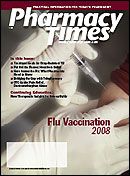Editor's Note: Pharmaceuticals in Drinking Water
The recent controversy of pharmaceuticals found in drinking water has raised questions about the proper disposal of pharmaceuticals.
Mr. McAllister is a health-systems consultant based in Chapel Hill, North Carolina.

Over the past 2 years, you mayhave read an article in the laypress on pharmaceuticals gettinginto the drinking water. Findingmeasurable amounts of drugs in thedrinking water is a global issue, withreports documenting contaminationcoming from Europe, the UnitedKingdom, Japan, Canada, and theUnited States. The Associated Press(AP) has been reporting on this phenomenonfor some time, but in March2008, following a 5-month investigation,the AP reported that a myriadof pharmaceuticals were found in thedrinking supplies of over 40 millionAmericans. Drugs found included antibiotics,analgesics, non-steroidal anti-inflammatorydrugs, hormones, anti-epileptics,and more.
The source of drinking water contaminationby pharmaceuticals includesnormal human consumption, followedby excretion of both unmetabolizeddrugs as well as metabolites. Perhapsthe most significant contributing factor,however, is that almost 6000 hospitalsand 45,000 long-term care facilitiesdiscard an estimated 250 millionpounds of pharmaceuticals and pharmaceuticalwaste each year. Many ofthese facilities dispose much of theirpharmaceutical waste in the sink ortoilet or in local landfills. It is interestingthat, over 30 years ago, manyhospitals were incinerating much ofthis waste, but legislative efforts toreduce air pollution forced facilitiesto find other ways to discard waste.The Environmental Protection Agency(EPA) has recently recognized that disposalin the trash is considered a bestmanagement practice, even though weknow that drugs eventually leach intowatersheds.
Apparently, very few water providerseven test the water for pharmaceuticalcontaminants, nor are many watershedstested. It is true that the hazardsassociated with long-term exposure tominute amounts of drugs have not beenadequately researched. The AP investigationand reports prompted hearingsat the state and federal levels andprobably increased interest in learningmore, but the fact remains that no federallaws or even EPA guidelines existabout the disposal of pharmaceuticals,in contrast to strict rules for disposingoil and other contaminants.

Few of us would suggest that exposingthe public, especially pregnantwomen, children, and seniors, to anyamount of drugs in the drinking wateris safe. Yet, reflection on my career inhospitals reveals that it never reallyoccurred to me what our departmentwas doing as we poured unused intravenousfluids, tablets, capsules, andother drugs down the drain, in thetoilet, or into the trash. Most hospitalshave specific mechanisms to segregateand discard hazardous waste, especiallysharps, and chemotherapy waste isoften included. Perhaps we can examinewhether our waste could be addedto our hazardous waste disposal programor another existing mechanismto avoid drugs seeping into the watersupply.
In addition, several companies offerprograms and services that assist hospitalsand their pharmacies to disposeof unusable drugs in an eco-friendlyway.
It seems to me that organized pharmacyshould not wait for research toprove that public exposure to pharmaceuticalsis harmful. Don't we alreadyknow that? We also should not waitfor regulators to mandate how pharmaceuticalwaste is most appropriatelydisposed. We should lead an initiativein each of our hospitals (and long-termcare facilities and the pharmacies thatserve them) to minimize or eliminatepharmaceutical waste that could findits way into our drinking water. Whileoutsourcing this problem for resolution,I suggest that hospitals, health systems,and long-term care facilities canconvene relevant stakeholders to developcost-effective solutions to eliminateor minimize drugs reaching the watersupply. What do you think?

